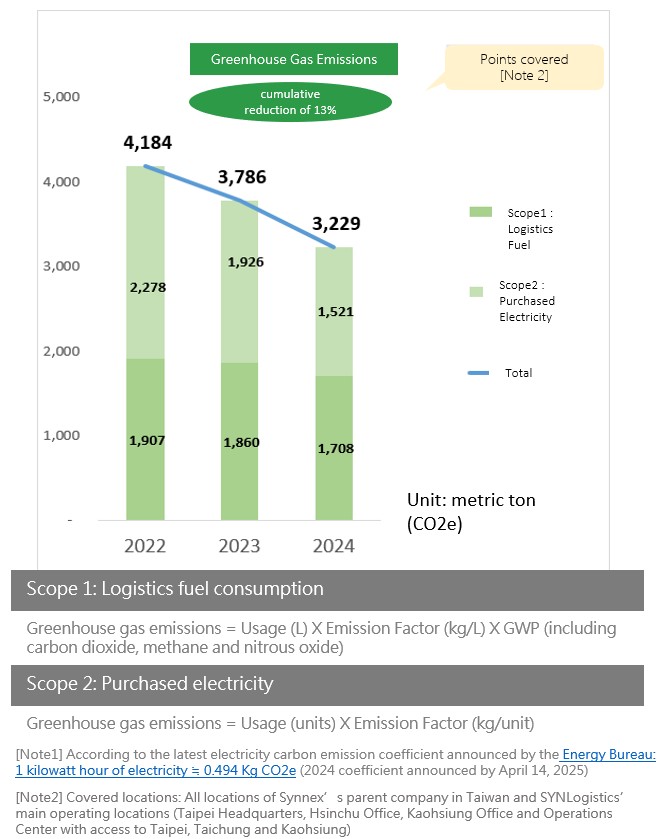Goals and Results
Since 2021, Synnex has established a greenhouse gas emissions inventory. In 2022, the company implemented the ISO 14001 Environmental Management System and ISO 14064 Greenhouse Gas Verification, achieving dual ISO certification.
In addition to obtaining international certifications, Synnex has proactively set carbon reduction targets, committing to a 25% reduction in carbon emissions by 2030, using 2023 as the baseline year. To ensure steady progress toward this goal, the company reviews key action plans for the following year on an annual basis, continuously enhancing operational efficiency and reducing carbon emissions, thereby fulfilling its commitment to environmental sustainability.
Greenhouse Gas Emission Sources
The greenhouse gas emissions of Synnex can be categorized into direct emissions (Scope 1) and indirect emissions (Scope 2). The sources are described as follows:
- •Direct Emissions (Scope 1): Logistics Fuel
- •Indirect emissions (scope 2): Purchased electricity
This report's greenhouse gas calculations use the updated electricity carbon emission coefficient from the Energy Bureau of the Ministry of Economic Affairs (April 14, 2025, for 2024) and the 2021 United Nations Intergovernmental Panel on Climate Change (IPCC) Sixth Assessment Report, which assesses global warming potential (GWP) over 100 years, converting all emissions to carbon dioxide equivalents (CO2e).
In 2024, Synnex‘s greenhouse gas inventory boundary includes all locations of the parent company, and covers the total emissions of the subsidiary’s main operating locations, which is equivalent to approximately 3,229 metric ton of CO2e. The total amount has dropped by nearly 23% compared to 2022.
In terms of emission intensity, the MSP has achieved economic of scale, and Synnex Group has also continued to promote energy-saving measures.
•(Scope 1) Logistics fuel consumption: 11.50 metric ton CO2e per vehicle

•(Scope 2) Purchased electricity: 0.019 metric ton CO2e per square meter


Energy Management
Synnex's internal energy consumption primarily involves non-renewable energy sources such as purchased electricity and fuel used for logistics delivery vehicles. The key details are as follows:
•Taipei Headquarters: This is a commercial office building where the main energy consumption is from purchased electricity used for information technology equipment rooms, air conditioning systems, and lighting.
•Logistics Center: Energy consumption at the logistics center mainly comes from purchased electricity used for automated storage equipment and lighting, as well as fuel for logistics delivery vehicles.
The relevant data sources include:
•Taiwan Power Company: Electricity bills, Fuel Records: Fueling records for logistics delivery vehicles. Energy Bureau.
The energy consumption data is calculated using the following formula:
Energy consumption
=Energy usage*Energy Content*Energy Unit Conversion
Identification results: Compared with 2023, total energy consumption in 2024 will decrease by 17% to 31,729 (GJ)
-Scope 1: Logistics fuel consumption: Optimize logistics routes and trips to minimize fuel consumption.
-Scope 2: Each branch continues to promote power-saving measures, centralize operations and consolidate idle space. Even if it is integrated into the parent company's complete base, it can still reduce power consumption.

Logistic fuel consumption
In 2024, fuel consumption dropped slightly by 16% to 20,172 (GJ)
•Fuel intensity: Slightly increased by 16%, to 144.09 (GJ) per vehicle
•Cause analysis:Decreased shipments can raise vehicle density by 26.73 GJ compared to last year.
•Strategy: Optimizing system mechanisms to enhance distribution network and home service efficiency.

Purchased Electricity
Electricity consumption in 2024 will drop by 18% to 11,557 (GJ)
•Electricity intensity: dropped by 18% to 0.14 GJ/m2 in 2024
•Cause analysis: Replace energy-intensive equipment and consolidate operations.
•Strategy: Comply with ISO standards and evaluate energy-saving measures.

[Note ] Covered locations: All locations of Synnex’s parent company in Taiwan and SynLogistics’ main operating locations
(Taipei Headquarters, Hsinchu Office, Kaohsiung Office and Operations Center with access to Taipei, Taichung and Kaohsiung)